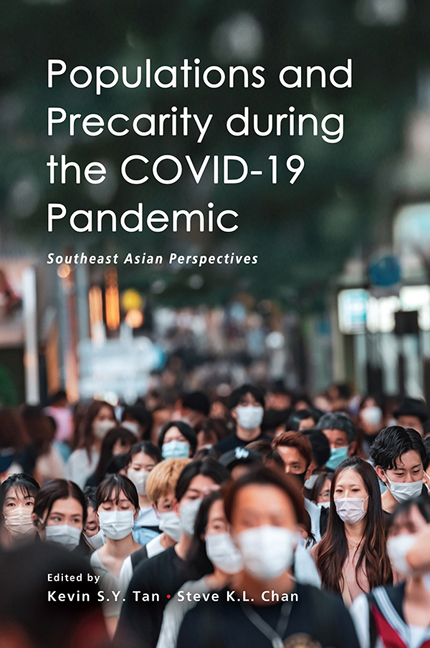Book contents
- Frontmatter
- Contents
- Preface
- About the Contributors
- 1 Introduction: Populations, Precarity and the COVID-19 Pandemic
- 2 Transformation of the Family Structure in Southeast Asia: Trends and Implications
- 3 New Normal, Old Ties: COVID-19’s Social Impact on the Singapore-Johor Bahru Connection
- 4 Unequal Flows: Examining the Factors Surrounding Thai and Vietnamese Labour Migration to South Korea
- 5 Emplacing Multiculturalism: Southeast Asian Migrant Linguistic Acculturation Programmes and Community Building in South Korea
- 6 “Foreign Talent” in Singapore and Some Implications for Schools
- 7 Managing Disaster Risk and Enabling Social Protection in Thailand: Some Lessons from the COVID-19 Pandemic
- 8 Transnational Housing Insecurity: Mobility, Homelessness, and the COVID-19 Pandemic
- 9 Older Persons with Hearing Disabilities in Indonesia: Vulnerability and Demographic Diversity during the COVID-19 Pandemic
- Index
8 - Transnational Housing Insecurity: Mobility, Homelessness, and the COVID-19 Pandemic
Published online by Cambridge University Press: 01 March 2024
- Frontmatter
- Contents
- Preface
- About the Contributors
- 1 Introduction: Populations, Precarity and the COVID-19 Pandemic
- 2 Transformation of the Family Structure in Southeast Asia: Trends and Implications
- 3 New Normal, Old Ties: COVID-19’s Social Impact on the Singapore-Johor Bahru Connection
- 4 Unequal Flows: Examining the Factors Surrounding Thai and Vietnamese Labour Migration to South Korea
- 5 Emplacing Multiculturalism: Southeast Asian Migrant Linguistic Acculturation Programmes and Community Building in South Korea
- 6 “Foreign Talent” in Singapore and Some Implications for Schools
- 7 Managing Disaster Risk and Enabling Social Protection in Thailand: Some Lessons from the COVID-19 Pandemic
- 8 Transnational Housing Insecurity: Mobility, Homelessness, and the COVID-19 Pandemic
- 9 Older Persons with Hearing Disabilities in Indonesia: Vulnerability and Demographic Diversity during the COVID-19 Pandemic
- Index
Summary
Transnational migrants are vulnerable to homelessness and form a large proportion of the homeless population in many places (Crisis 2021; Parliament of Victoria 2021; Pleace 2010; Smith 2018, 2019). Their housing insecurity is associated with barriers to work, housing and welfare (Amundson 2017; Daly 1996; Djuve et al. 2015; Fitzpatrick et al. 2015; Mostowska 2013). They are often excluded from the formal labour market due to limited rights to work and restricted to the least desirable housing options because of the precarity of informal work. Access to housing and other welfare services is further hindered by poor understanding of local practices, language and bureaucratic barriers, and fear of repatriation or deportation. Most of the literature is concerned with the housing experiences of refugees and asylum seekers (Smith 2018), or labour migrants who relocate for economic reasons, instead of highly mobile transnational persons who make frequent and repeated border crossings (for exceptions, see Campbell and Lachica 2013; Järv et al. 2021).
During the COVID-19 pandemic, homelessness spiked in many countries due to an increase in unemployment, poverty and evictions (Benavides and Nukpezah 2020; Benfer et al. 2021). Persons sleeping in public spaces faced greater exposure to infection and other physical and mental health risks (Udechukwu et al. 2021; Wang et al. 2021). In response, governments introduced emergency food and shelter services; stepped up outreach, rental assistance and temporary housing; suspended evictions; distributed personal hygiene items; and provided health and safety information (Fitzpatrick et al. 2020; Honorato and Oliviera 2020; Kelleher and Norris 2020; OECD 2021; Parsell et al. 2020; Wilczek 2020). The impact of the pandemic was heightened for economically marginalized labour migrants whose livelihoods were disrupted by travel restrictions (Shahare 2021). While refugees were targeted with stricter lockdown measures in some cases (Spyratou 2020), governments in places like the United Kingdom and Germany lifted rules that normally excluded migrants from accessing housing and welfare support (Barbu et al. 2021).
In Southeast Asia, the pandemic also affected migration and transnational populations. Within the region, migrants typically move from Myanmar to Thailand, from Indonesia to Malaysia, and from Malaysia to Singapore (Lian et al. 2016). The corridor between Singapore, Malaysia and Indonesia sees particularly heavy migration flows (Testaverde et al. 2017).
- Type
- Chapter
- Information
- Populations and Precarity during the COVID-19 PandemicSoutheast Asian Perspectives, pp. 120 - 143Publisher: ISEAS–Yusof Ishak InstitutePrint publication year: 2023



